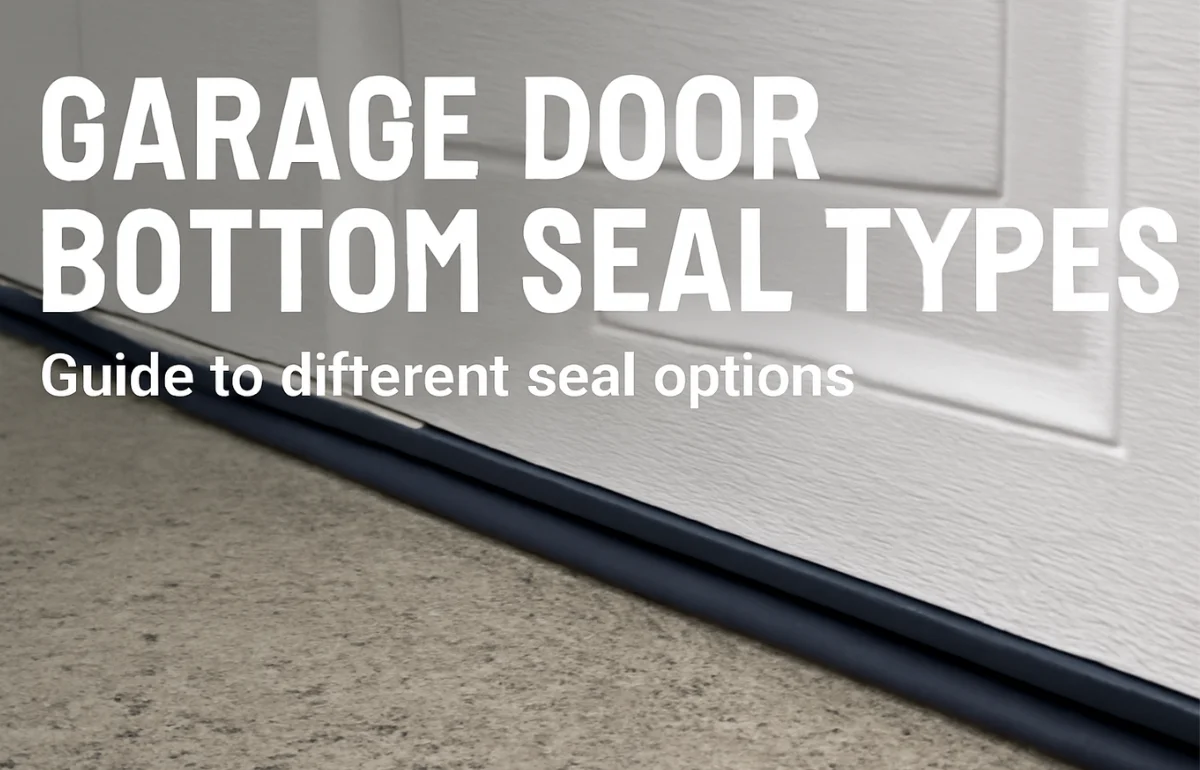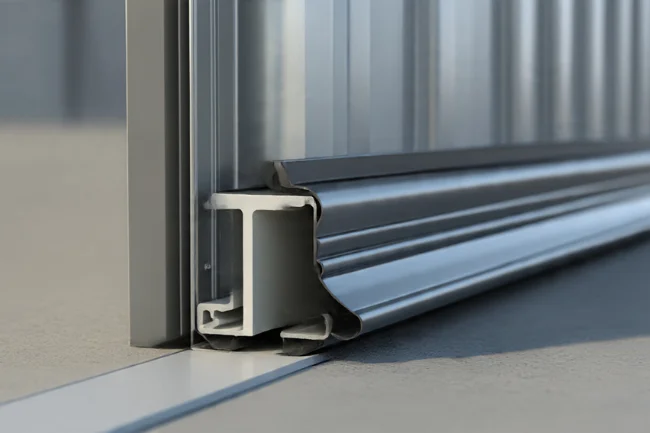
When it comes to garage door maintenance, one of the most important elements often overlooked is the garage door bottom seal. Understanding the different garage door bottom seal types is essential for keeping your garage protected from the elements, ensuring energy efficiency, and preventing drafts. In this article, we’ll dive deep into the various garage door bottom seal types and explore how each can benefit your home.
Garage Door Bottom Seal Explained
The garage door bottom seal is a crucial component installed along the bottom edge of your garage door. It’s designed to seal the gap between the door and the floor, preventing air, dirt, water, and pests from entering. There are several garage door bottom seal types, and choosing the right one is important for optimal protection. Over time, these seals can wear out, which is why knowing the available garage door bottom seal types will help you maintain your garage efficiently.
Choosing Among Different Garage Door Bottom Seal Types
Each garage door bottom seal type has its own set of benefits, depending on your needs and the design of your garage door. From materials to shape and design, let’s break down the most popular garage door bottom seal types available on the market.
1. T-style Garage Door Bottom Seals

Overview:
The T-style garage door bottom seal features a T-shaped profile, which fits securely into a groove on the door. This is one of the most common garage door bottom seal types used for standard metal garage doors.
Advantages:
-
Provides a strong, tight seal that keeps drafts, dirt, and water out.
-
Works well with most metal doors.
-
Effective in keeping the garage insulated during both cold and hot weather.
Disadvantages:
-
Installation requires a groove on the door, making it more suitable for metal doors.
-
Not ideal for non-traditional or wooden garage doors.
2. U-style Garage Door Bottom Seals
Overview:
U-style garage door bottom seals have a U-shaped profile that fits directly over the edge of the door. This seal type is one of the easiest to install and is compatible with various garage door types.
Advantages:
-
Simple to install with minimal tools.
-
Works well with both wooden and metal garage doors.
-
Provides a strong barrier to prevent drafts and pests.
Disadvantages:
-
May wear down more quickly in harsh weather conditions compared to other seals.
3. Bulb-style Garage Door Bottom Seals
Overview:
The bulb-style garage door bottom seal is known for its round, bulbous shape, which compresses against the floor to create a tight seal. This seal is made of durable rubber or vinyl, making it highly effective for insulation.
Advantages:
-
Flexible and durable, ensuring a perfect seal even on uneven floors.
-
Great for blocking dirt, water, and noise.
-
Fits the needs of residential and commercial setups.
Disadvantages:
-
Over time, the bulb may lose its shape and compress, requiring more frequent replacements.
4. Vinyl Garage Door Bottom Seals

Overview:
Vinyl garage door bottom seals are popular because of their affordability and ease of installation. These seals often come with a metal retainer to enhance their durability.
Advantages:
-
Budget-friendly, making it an economical choice for many homeowners.
-
Can be installed or replaced easily without expert assistance.
-
Provides decent protection from the elements.
Disadvantages:
-
May not perform well in extreme temperatures or under heavy weather conditions.
5. Rubber Garage Door Bottom Seals
Overview:
Rubber garage door bottom seals are the most durable of the garage door bottom seal types. They can withstand various weather conditions, including rain, snow, and intense heat, making them ideal for extreme climates.
Advantages:
-
Tough and long-lasting, even under heavy use.
-
Excellent for insulating against temperature fluctuations.
-
Functions efficiently no matter the weather.
Disadvantages:
-
Higher initial cost compared to other seal types.
-
Installation can be more complex depending on the door’s design.
Table: Comparison of Garage Door Bottom Seal Types
| Seal Type | Material | Compatibility | Weather Resistance | Ease of Installation | Durability |
|---|---|---|---|---|---|
| T-style Seal | Rubber, Vinyl | Standard Metal Doors | Good | Medium | High |
| U-style Seal | Rubber, Vinyl | Wooden & Metal Doors | Good | Easy | Medium |
| Bulb-style Seal | Rubber, Vinyl | Uneven Floors, All Doors | Excellent | Medium | High |
| Vinyl Seal | Vinyl | All Door Types | Fair | Easy | Medium |
| Rubber Seal | Rubber | All Door Types | Excellent | Hard | Very High |
A Homeowner’s Guide to Garage Door Bottom Seal Selection
When selecting the right garage door bottom seal type, consider several factors such as your local climate, the material of your garage door, and your budget. For example, if you live in an area with harsh winters or frequent rain, opting for a rubber or bulb-style seal will provide the best protection. If you’re on a budget, a vinyl or U-style seal might be a more economical option.
Tips for Choosing the Best Seal for Your Garage Door:
-
Check Compatibility: Ensure the seal you choose is compatible with your garage door material.
-
Consider Local Weather: Choose a seal type based on the weather conditions in your area, such as extreme heat or cold.
-
Long-Term Durability: Investing in a durable material like rubber can save you money in the long run, even if the upfront cost is higher.
FAQ
1. How do I know when to replace my garage door bottom seal?
If your garage door bottom seal shows visible cracks, holes, or has compressed and lost its shape, it’s time for a replacement.
2. Can I install the garage door bottom seal myself?
Yes, many garage door bottom seal types are easy to install with minimal tools. T-style seals may require more effort but are still manageable for DIYers.
3. What’s the best material for a garage door bottom seal in extreme weather?
Rubber seals are the best option for extreme weather conditions as they are highly durable and offer great insulation.
4. How do I maintain my garage door bottom seal?
Check your garage door bottom seal regularly for wear and tear, clean it to remove debris, and replace it as soon as wear or cracks appear.
5. Can I replace just the bottom seal or do I need to replace the entire door?
You can replace just the garage door bottom seal in most cases, which is a cost-effective way to restore the door’s function and insulation.
Conclusion
Selecting the right garage door bottom seal type is essential for ensuring your garage remains sealed from the elements. Whether you choose a T-style, U-style, or rubber seal, each has unique advantages based on your specific needs. Don’t wait until your seal is worn out—replace it with a new one today and enjoy a more energy-efficient, protected garage.
I’m Salman Khayam, the founder and editor of this blog, with 10 years of professional experience in Architecture, Interior Design, Home Improvement, and Real Estate. I provide expert advice and practical tips on a wide range of topics, including Solar Panel installation, Garage Solutions, Moving tips, as well as Cleaning and Pest Control, helping you create functional, stylish, and sustainable spaces that enhance your daily life.
